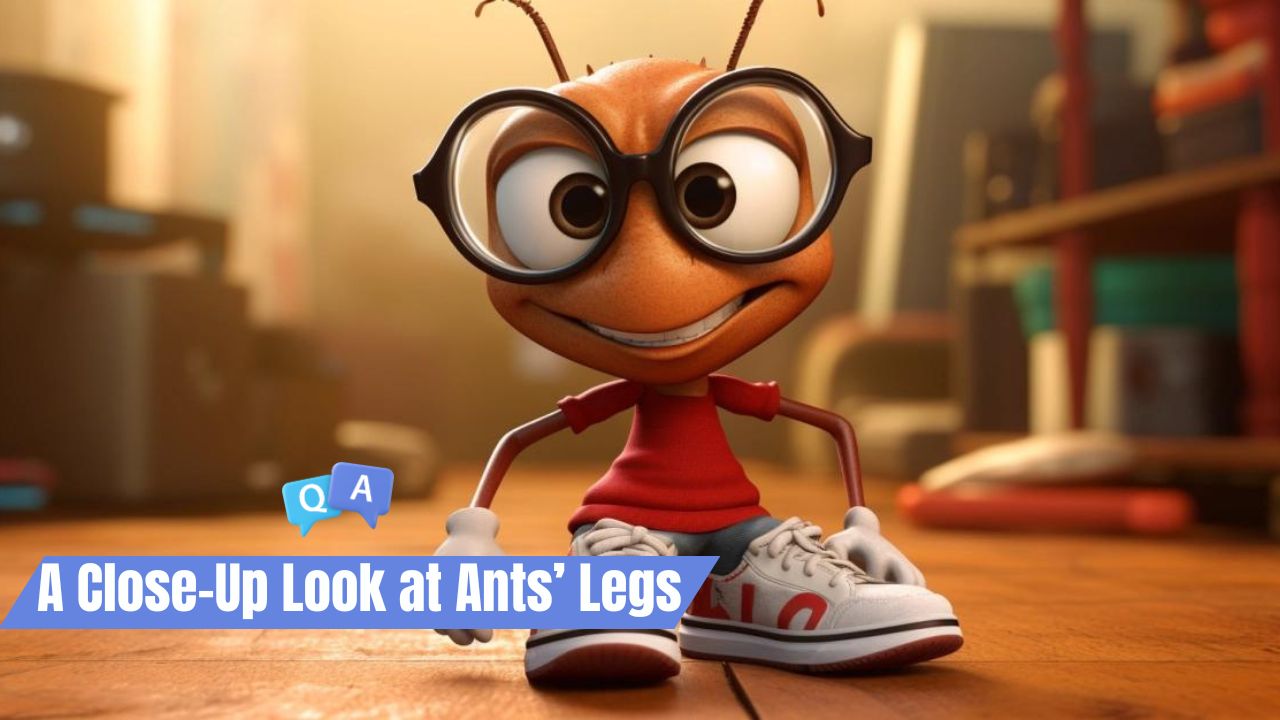TL;DR Summary:
Ants, remarkable for their efficiency and adaptability, have six legs – a key feature that defines them as hexapods. These legs are not just for movement; they are intricately adapted tools essential for an ant’s survival. Their legs allow for incredible feats like carrying objects many times their weight, navigating diverse terrains, building complex nests, and coordinating within their colonies. Each leg is equipped with muscles for strength and precision, sensory organs for environmental interaction, and adaptations unique to their specific habitat. The study of ant legs reveals the extraordinary capabilities of these small creatures and underscores the marvels of natural engineering in even the tiniest of life forms.
As Professor Abigail Antenna, a lifelong myrmecologist, I have been captivated by the world of ants, these tiny architects of the earth. Among the many questions I encounter, one that often scurries to the forefront is, “How many legs do ants have?” Understanding the answer opens a window into the marvels of ant physiology and the evolution of these industrious creatures. Let’s embark on a journey into the realm of ants, examining the form and function of their legs and the critical roles these limbs play in their daily survival.
The Quest to Understand Ant Legs
- Curiosity and Inquiry: My quest to understand ant legs stems from a broader fascination with how these insects accomplish remarkable feats of strength and coordination. Their legs are not just appendages; they are pivotal tools that define their interaction with the environment.
- Beyond Counting: While counting legs may seem a simple task, it reveals complex biological machinery. Each leg is a testament to millions of years of evolution, finely tuned for tasks that are crucial to the ant’s survival.
- A Glimpse into Evolution: By studying ant legs, we also gain insights into the evolutionary pressures that have shaped these organisms. Each segment and joint tells a story of adaptation and survival.
Why Ant Leg Count Matters
- Foundation of Mobility: The number of legs an ant has is fundamental to its mobility. As a hexapod, an ant’s six legs provide stability and speed, allowing it to navigate the varied landscapes it inhabits.
- An Indicator of Health: Leg count is also an indicator of an ant’s health and developmental success. A full complement of legs is essential for an ant’s ability to contribute effectively to its colony.
- Reflecting Complexity: Beyond mere numbers, the count reflects the complexity of ant anatomy and the specialized roles each leg plays. It’s a starting point for understanding the broader complexities of ant biology.
Previewing Ant Anatomy
- Structural Overview: Ants, like all insects, possess a segmented body plan comprising the head, thorax, and abdomen. Their legs are attached to the thorax, each segment playing a distinct role in movement and sensory perception.
- Mechanical Marvels: Ant legs are mechanical marvels, equipped with muscles, joints, and sensors that allow for intricate movements and strength that defies their size.
- Anatomy and Behavior: As we preview ant anatomy, we see that the design of an ant’s legs is intimately linked to its behavior — from foraging and digging to caring for the young and defending the colony.
In the coming sections, we will delve deeper into the intricacies of ant legs, from their basic anatomy to the impressive mechanics of their movement, and how these relate to the ant’s survival and success as one of the planet’s most successful organisms. Join me in uncovering the fascinating world that unfolds just beneath our feet, a world where six legs allow for a multitude of possibilities.
The Basic Anatomy of an Ant

Within the bustling world of ants, their anatomy is a subject of endless fascination for entomologists like myself. Ants are invertebrates that belong to the class Insecta, and their bodies are a marvel of evolutionary design, optimized for survival and efficiency. Let’s break down the fundamental anatomy of these incredible creatures.
Head, Thorax, and Abdomen
- Central Processing Unit: The Head: The head of an ant is where the brain resides, a dense cluster of nerve cells that coordinate the ant’s sensory input and motor functions. It’s also home to the ant’s compound eyes, antennae for sensing chemicals and movement, and mandibles which are used for carrying objects, digging, or defense.
- The Motor: The Thorax: The thorax is the powerhouse of an ant’s body, housing the muscles that power the legs and wings (in reproductive ants). This middle segment is where all six legs are attached, each leg being a complex assembly of parts that allow for versatile movement.
- The Engine Room: The Abdomen: The abdomen contains vital organs, including the digestive system and reproductive organs. In queen ants, the abdomen is significantly larger, as it is the site for egg development. The abdomen also has the exocrine glands that produce pheromones for communication.
Limb Attachment and Function
- The Attachment Point: Each leg is attached to the thorax at a segment called the coxa, which acts as a pivot point, giving the leg a wide range of motion. The coxa leads to a series of segments that culminate in the tarsus, or foot, which often has tiny claws for gripping surfaces.
- A Symphony of Movement: The legs operate in coordinated sequences for walking, running, or carrying objects. The ant’s gait is a complex interplay of its legs working in unison to move quickly and efficiently over a variety of terrains.
- Multipurpose Tools: Beyond locomotion, ant legs serve various functions. They are used to manipulate objects, engage in social interactions, groom themselves or nestmates, and in some species, to communicate through vibrations.
Variations Across Species
- Diverse Forms for Diverse Functions: While the basic anatomical plan of ants is consistent, there are variations across the 12,000-plus known species. These variations often correspond to the ant’s habitat and lifestyle. For example, species that burrow have stronger, more robust legs for digging, while tree-dwelling species might have longer, more agile legs for navigating foliage.
- Specialized Extremities: Some species exhibit specialized limbs; trap-jaw ants have modified legs that aid in their spring-loaded hunting technique, while honeypot ants have workers whose hind legs can support an engorged abdomen, filled with food for the colony.
- Size Matters: The size of an ant influences its leg structure and strength. Larger species tend to have proportionally thicker legs, providing the necessary support to carry heavier loads relative to their body weight.
The basic anatomy of an ant is a testament to its evolutionary success. The head, thorax, and abdomen form a trio of functionally distinct regions, each playing a critical role in the ant’s survival. The legs, attached to the thorax, are marvels of biological engineering, enabling the ant to perform a wide array of tasks that are vital to its daily life and the well-being of the colony. Understanding these structures is key to appreciating the complexity and capability of these small yet mighty creatures.
Counting the Legs of an Ant

In my years of peering through the lens of a microscope at the tiny, bustling figures of ants, the precision of their design never ceases to amaze me. Central to their design is a feature most are curious about: the number of legs. Let’s delve into the details of an ant’s legs, which play a critical role in their survival and are a fundamental aspect of their biology.
The Magic Number: Six
- Consistent Across Species: In the diverse world of ants, from the leaf-cutter to the formidable army ant, one aspect remains consistent — each ant is equipped with six legs. This hexapod arrangement is a defining characteristic of all insect species, including ants.
- An Evolutionary Success: The number six is not arbitrary; it is an evolutionary success story. This configuration provides a balance of stability and mobility, which is critical for the ant’s varied activities such as foraging, climbing, and tunneling.
- A Rhythmic Dance: Watching ants, you’ll notice a rhythmic dance as they move. Three legs are always on the ground, providing support while the other three propel the ant forward. This tripod gait is the secret to their remarkable balance and agility.
Leg Pairings and Coordination
- A Triad of Pairs: An ant’s legs are paired off into three sets: the front, middle, and hind legs. Each set plays a unique role. The front legs often act as sensory probes, the middle as stabilizers, and the hind legs provide the thrust for movement.
- Neural Coordination: The ant’s nervous system is finely tuned to coordinate these pairs. This neural coordination allows for complex maneuvers, such as turning sharply to evade a predator or skillfully maneuvering around obstacles.
- Synchronized Movements: The legs on one side of the body move in concert with the opposite side’s corresponding leg, allowing for a variety of walking patterns. This synchronization is particularly evident when ants carry large items back to their nest, requiring precise teamwork.
The Significance of Being Hexapods
- Stable Yet Versatile: As hexapods, ants have a stable platform for carrying objects or negotiating rough terrain. But stability does not come at the cost of versatility. The six-legged design allows for a remarkable range of movements and speed.
- Energy Efficiency: The hexapod structure is also energy efficient. Ants can cover long distances in search of food without expending excessive energy, which is vital for their survival, given their small size and high-energy lifestyles.
- Adaptation and Evolution: Being hexapods has allowed ants to adapt to nearly every terrestrial environment on Earth. This six-legged design has been so successful that it has endured through millions of years of evolution, a testament to its effectiveness.
The magic number six is a cornerstone of ant anatomy and behavior. It is a number that signifies strength, agility, and adaptability. In the context of myrmecology, it is a number that represents much more than a count; it embodies the essence of ant functionality and their success as a species. The hexapod arrangement is indeed a marvel of nature, a simple answer to many complex challenges of survival.
The Mechanics of Ant Locomotion

As I often explain to my students, the way ants move is not just fascinating; it’s a showcase of evolutionary engineering. The mechanics of ant locomotion are a symphony of biological components working in flawless harmony. Let’s explore the muscle structure and coordination that underlie this remarkable aspect of ant physiology.
Muscle Structure and Movement
- Intricate Muscular System: Ants possess a complex muscular system that allows for precise control over each leg. Their muscles are attached to the exoskeleton, operating much like a series of levers and pulleys. When a muscle contracts, it pulls on the exoskeleton, creating movement at the joint.
- Strength and Precision: Despite their minute size, ants have incredibly strong muscles relative to their body weight, which is why they can carry objects many times heavier than themselves. The precision of their muscle control also allows for delicate tasks, such as manipulating small food items or constructing intricate tunnels.
- Efficient Respiration: Ants have an open circulatory system and their muscles receive oxygen directly from their spiracles – tiny openings on their bodies that connect to a network of tubes called tracheae. This efficient respiratory system supports their high levels of activity and muscular demand.
Coordination Across Multiple Legs
- Neural Control: Coordination across the ant’s six legs is governed by a sophisticated neural system. While ants don’t have a centralized brain like mammals, their nervous system includes ganglia, which are clusters of neurons that process sensory information and coordinate muscle movements.
- The Tripod Gait: Ants typically employ a tripod gait, where they move three legs at a time — two on one side and one on the opposite. This gait provides stability while allowing for rapid movement. An ant can quickly alter its gait in response to changes in the environment, such as when navigating uneven terrain.
- Sensory Feedback: Sensory feedback from the legs to the nervous system is crucial for this coordination. The sensory organs located on the legs help ants detect and respond to surface textures and vibrations, allowing for adjustments in leg movements to maintain balance and speed.
Speed and Efficiency in Ant Travel
- Optimized for Speed: The structure of an ant’s legs, combined with its gait, is optimized for speed. The relative length of their legs and the speed at which they can move them allow ants to cover ground quickly, a necessity for foraging and escaping predators.
- Energy Conservation: Ants are also masters of energy conservation. Their movements are efficient, with minimal energy waste. This efficiency is essential for their survival, particularly for species that travel great distances from the nest to find food.
- Role of the Environment: The locomotion of ants is not only a matter of internal mechanics but also a response to the external environment. Whether they’re scaling vertical surfaces, traversing water, or digging through soil, ants adjust their locomotive strategies to meet the demands of their habitat.
The mechanics of ant locomotion reveal a creature perfectly attuned to its life’s demands. From the power and precision of their muscle movements to the coordination across their six legs, ants demonstrate an extraordinary mastery of movement. This mastery allows them to thrive in environments ranging from the rainforest floor to the arid desert, making ants one of the most successful and ubiquitous creatures on the planet. Understanding the intricacies of their movement is not just about appreciating their agility and strength; it’s about recognizing the intricate dance of life that plays out in even the smallest of Earth’s inhabitants.
Adaptations in Ant Legs

In my extensive study of ant biomechanics, I’ve been consistently amazed at the myriad of adaptations their legs have evolved for survival. These adaptations are not just for locomotion; they enable ants to climb with agility, carry loads that dwarf their own bodies, and sense the world around them with remarkable acuity. Let’s explore these specialized adaptations in detail.
Climbing Abilities
- Structural Adaptations for Grip: Ants are equipped with specialized structures on their legs that allow them to scale vertical and upside-down surfaces with ease. Their claws, or tarsi, can grip and release with incredible precision, enabling them to walk across leaves, wood, and even glass.
- Adhesive Pads: Some species, such as the weaver ants, have adhesive pads called arolia that can be deployed when extra grip is needed. These pads can stick to smooth surfaces, allowing the ants to defy gravity as they forage or hunt.
- Body Weight Distribution: Ants have also evolved a way to distribute their body weight to optimize climbing efficiency. Their lightweight exoskeletons and the distribution of muscle strength in their legs give them the ability to support their body mass even when hanging upside down.
Carrying Capacity and Strength
- Leverage and Load Bearing: The ant’s leg muscles are incredibly strong for their size, allowing them to carry objects many times their own weight. This strength is partly due to the leverage provided by the long segments of their legs, acting like cranes to lift and transport heavy loads.
- Energy-Efficient Carriage: Ants are masters of energy-efficient load carriage. Their gait adjusts when carrying objects to minimize energy expenditure, allowing them to transport food or materials over long distances back to the nest.
- Teamwork and Coordination: When loads are too heavy for a single ant, teamwork comes into play. Groups of ants will coordinate their efforts, with each ant adjusting its strength and position to effectively move large items as a unit.
Sensory Functions of Legs
- Vibrational Sensors: Ant legs are equipped with sensory hairs and organs that detect vibrations in the ground. These vibrations can signal the approach of predators, the movements of prey, or the footsteps of colony members, providing critical information about their environment.
- Chemical Detection: The legs also contain chemoreceptors that can pick up chemical trails left by other ants. These trails are essential for navigation and communication, guiding ants to food sources or alerting them to danger.
- Tactile Exploration: The legs, particularly the front pair, are used for tactile exploration. Ants will tap their legs on the ground or objects to explore their texture and shape, which helps in identifying food items and navigating through complex terrain.
The adaptations of ant legs are a remarkable example of evolutionary ingenuity. Through climbing abilities, carrying capacity, and sensory functions, ants have become one of the most successful groups of animals on the planet. Their legs are not mere appendages for movement but are versatile tools that have enabled ants to conquer nearly every terrestrial habitat on earth. These adaptations highlight the extraordinary ways in which ants interact with their environment and overcome the challenges of survival with finesse and strength.
Ant Legs in Colony Life

In the bustling microcosm of an ant colony, each member’s legs are critical to their collective existence. My studies have revealed that the role of ant legs extends far beyond individual needs, contributing to the colony’s survival. From foraging and nest building to defense, the legs of an ant are indispensable tools for daily life in the colony.
Foraging and Food Transport
- Expert Foragers: Ants are expert foragers, and their legs are essential for this task. They travel vast distances relative to their size, with their sturdy legs carrying them over rough terrain and through dense vegetation in search of food.
- Transporting Supplies: Once food is found, the strength in their legs allows ants to carry these provisions back to the nest. Some species can transport items up to 50 times their own body weight — a feat made possible by the robust musculature of their legs.
- Trail Formation: As foragers, ants use their legs to lay down and follow pheromone trails, ensuring a straight path to and from food sources. These trails are the highways of the ant world, created and maintained by the constant travel of many tiny feet.
Nest Building and Excavation
- Architectural Engineers: The construction of a nest is a marvel of ant engineering, and their legs are central to these efforts. Whether it’s excavating underground tunnels or building elaborate structures above ground, each leg movement is purposeful and precise.
- Material Manipulation: The legs are used to manipulate building materials, such as soil, plant matter, or even their own silk. The coordination between the legs allows ants to perform complex tasks like weaving leaves together or sculpting soil into chambers and tunnels.
- Collaborative Construction: Nest building is a collaborative effort. The ants use their legs to communicate through gentle taps and strokes, coordinating their efforts and ensuring that each new addition to the nest structure is in the right place.
Defense and Attack Strategies
- Defenders of the Colony: Ant legs are not only for building and foraging but also for defense. In the face of a threat, ants can use their legs to run swiftly, either to retreat or to engage the intruder.
- Combat Tactics: In combat, ant legs deliver swift, coordinated strikes that can subdue or repel invaders. Some ants use their legs to grapple with opponents, holding them in place while delivering stings or bites.
- Chemical Warfare: Beyond physical combat, ants can also use their legs to release defensive chemicals. Certain species have glands in their legs that secrete substances to deter predators or to signal alarm to their nestmates.
The roles that ant legs play in colony life are as varied as the ants themselves. Foraging, nest building, and defense are just a few aspects of the vast repertoire of tasks these limbs perform. The complexity of these behaviors is a testament to the evolutionary success of ants. Their legs are more than mere appendages; they are essential instruments that facilitate the survival and prosperity of the colony. In every granule of soil moved, in every seed transported, and in every battle waged, the legs of an ant are there, silently and efficiently shaping the world beneath our feet.
The Impact of Environment on Ant Legs

The study of ants has long revealed that these creatures are not merely passive inhabitants of their environments; they are shaped by them in profound ways. The legs of ants, in particular, exhibit remarkable adaptations that reflect the diversity of habitats they occupy. Each environmental challenge leads to a unique evolutionary response, ensuring the survival of these industrious insects.
Adaptations to Different Habitats
- Diverse Habitats, Diverse Adaptations: Ants inhabit a wide range of environments, from rainforests and deserts to urban areas. Each of these habitats presents unique challenges, from the type of terrain to the availability of food and the presence of predators.
- Morphological Specialization: In response to these environmental pressures, the legs of ants have evolved specific adaptations. For example, desert ants have longer legs to keep their bodies away from the hot sand, while species that dwell in leaf litter often have shorter, stronger legs for navigating and digging through dense material.
- Behavioral Adaptations: It’s not just the physical structure of the legs that adapts to the environment but also the behavior. In colder climates, ants may use their legs to bask in the sun, increasing their body temperature before they begin daily activities.
Coping with Obstacles and Terrain
- Overcoming Obstacles: The rugged landscapes that ants traverse require robust locomotion strategies. Their legs have evolved to cope with every kind of obstacle, from smooth pebbles to jagged sticks.
- Terrain Specialists: Some ants have sticky pads or hooked claws to climb surfaces, while others have spines on their legs to anchor themselves in place against strong winds or water currents.
- Navigational Excellence: The legs are also critical for navigation. Ants can measure the distance they have traveled and integrate this information with visual cues. This is done through a process known as “stridulation,” where they use their legs to produce vibrations that aid in navigation.
Leg Loss and Regeneration
- Surviving Injuries: In the wild, ants can lose legs due to predation, fights, or accidents. However, ants are resilient; a loss of one or even two legs can be compensated for by adjustments in their gait and behavior.
- Regenerative Capabilities: Unlike some other arthropods, ants do not have the ability to regenerate lost limbs. Therefore, they must rely on the resilience of their bodies and the collective support of their colony to survive and continue to contribute.
- Colony Support: When an ant loses a leg, it is not abandoned by its peers. Instead, colony members may assist the injured ant, sharing food and helping it move until it adapts to its new condition.
The legs of ants, shaped by their environments, are a testament to the remarkable adaptability of these organisms. Whether it’s the dry expanse of a desert or the dense undergrowth of a rainforest, ants have evolved to meet the demands of their habitats. These adaptations showcase the intricate relationship between form, function, and environment. They highlight the incredible resilience of ants and their ability to thrive in virtually any setting. The study of ant legs, therefore, is not only a study of anatomy but also of ecological interplay and the enduring versatility of life.
Conclusion

As we conclude our exploration into the fascinating world of ants and the remarkable anatomy of their legs, it’s important to reflect on what these tiny creatures teach us about the majesty of nature’s engineering. My journey as a myrmecologist has consistently brought me back to the awe-inspiring intricacies of ant physiology and behavior, particularly the role and capabilities of their legs.
Summarizing the Role of Ant Legs
- Essential Tools for Survival: The legs of an ant are not just appendages for movement; they are essential tools that play a vital role in the ant’s survival. From foraging and food transport to nest building, each leg movement is critical for the day-to-day operations of the ant and the wellbeing of the entire colony.
- Adaptation and Specialization: Ant legs demonstrate remarkable adaptation and specialization, allowing these creatures to thrive in diverse environments. Whether it’s the long, heat-avoiding strides of a desert ant or the strong, digging limbs of a leaf-litter-dwelling species, each adaptation speaks to the ant’s ability to conquer environmental challenges.
- A Symphony of Coordination: The six-legged locomotion of ants is a symphony of coordination, strength, and precision. This locomotive method showcases the ants’ remarkable balance and agility, enabling them to perform complex tasks and carry loads several times their own body weight.
Reflecting on the Wonders of Ant Mobility
- A Microcosm of Efficiency: Ant mobility is a microcosm of efficiency and adaptability. Their movements, from the simple act of walking to the complex task of carrying large items, are testaments to the evolutionary success of their design.
- Harmony with the Environment: Ants demonstrate a harmonious interaction with their environment, with their legs playing a central role in navigating, adapting to, and manipulating their surroundings. This harmony is a delicate balance between form, function, and the ecological niche they occupy.
The Majesty of Miniature Engineering
- Beyond Size: The study of ant legs pushes us to look beyond the size of these creatures and appreciate the complexity contained within their tiny frames. It’s a reminder that sometimes, the most remarkable engineering is found in the smallest of packages.
- Inspiration for Human Innovation: The mechanics of ant legs provide inspiration for human innovation, from robotics to biomimicry in design. These small creatures have much to teach us about efficiency, strength, and resilience.
- A Testament to Nature’s Ingenuity: Ultimately, the legs of an ant are a testament to nature’s ingenuity. They encapsulate the essence of life’s ability to adapt, overcome, and thrive in the face of constant challenges.

